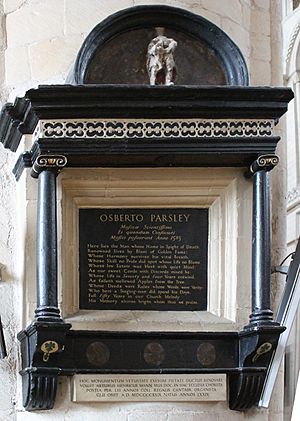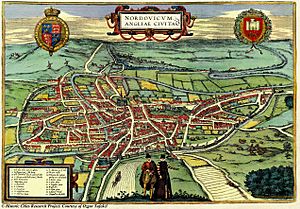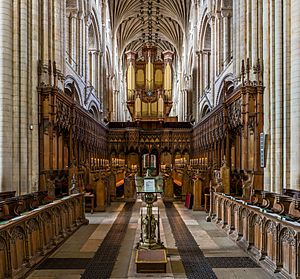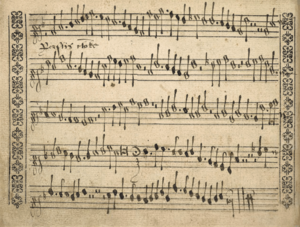Osbert Parsley facts for kids
Quick facts for kids
Osbert Parsley
|
|
|---|---|

The commemorative plaque to Parsley in Norwich Cathedral
|
|
| Born | 1510/1511 |
| Died | 1585 (aged 71) Norwich, England
|
| Occupation |
|
| Era | Renaissance |
Osbert Parsley (1510/1511–1585) was an English Renaissance composer and chorister. A Renaissance composer lived during a time of great change in art and music, roughly from the 14th to the 17th century. A chorister is someone who sings in a choir, often in a church.
Not much is known about Osbert Parsley's personal life. We know he got married in 1558. He lived for a while in a part of Norwich called St Saviour's Church parish. Parsley started his music career as a choirboy at Norwich Cathedral. He worked there for his entire life. He was first called a "lay clerk," which means a non-religious person who sang in the church. Around 1534, he became a "singing man." He was probably also the cathedral's unofficial organ player for about 50 years.
His career happened during the reigns of King Henry VIII and his three children. These were Edward VI, Mary I, and Elizabeth I. After the English Reformation in 1534, the lives of church musicians in England changed a lot. This was because the official rules about religion changed with each new ruler.
Parsley mostly wrote church music. He wrote songs for both Latin and English church services. His Latin songs are thought to sound more smooth and beautiful. His longest song is called Conserva me, domine. It was written in a graceful polyphonic style, which means it had many independent voice parts singing together.
Parsley also wrote other church music, like songs for morning and evening services. His five-part Lamentations is famous because the highest notes are very hard to sing. He also wrote instrumental music, mostly for viols. Viols are old string instruments, like a cello. His instrumental music mixes his Latin and English singing styles. Some of his instrumental music is still around today, even if it's not complete.
Osbert Parsley died in Norwich in 1585. He was buried in Norwich Cathedral. He received a special commemorative plaque there. This plaque showed how much people respected him and his music. It was a very rare honor for a chorister. The plaque has a poem that praises his good character and musical talent. Today, Parsley's music is sometimes played in church services and concerts. Some of his recorded songs include his Lamentations and Spes Nostra.
Contents
Osbert Parsley's Life and Music Career
Osbert Parsley was born in 1510 or 1511. We don't know who his parents were or exactly where he was born. Like many English composers of his time, he started his music journey as a choirboy. A choirboy is a young boy who sings in a church choir. While Parsley was a choirboy, Edmund Inglott and his son William Inglott were the leaders of the choristers.
Around 1534, Parsley became a "singing man." He kept this job for 50 years. Some historians think Parsley might have been a monk in training before the English Reformation changed everything. After that, he became a singing man. Parsley's name first appeared in Norwich Cathedral's records between 1538 and 1540. He was listed as a "lay clerk." He continued to be mentioned in the cathedral's records throughout his life. It's likely he was also the cathedral's unofficial organist from 1535 until he died in 1585.
In 1558, Parsley married a woman named Rose. They bought a house in Norwich. Parsley owned this house until 1583. We know from Parsley's will that he and Rose had seven children who survived. Their names were Henry, Edmund, John, Joan, Elizabeth, Dorothy, and Anne.
Composers during the Tudor period could get special honors. They might receive a degree from Oxford or Cambridge. Or they could become a member of the Chapel Royal, which was the royal choir. Parsley did not receive either of these special honors.
Later Years: The 1570s and 1580s
By the early 1570s, Parsley was earning £12 a year. The other five men in the cathedral choir were paid £10 or £8. This was about the same amount an unskilled construction worker earned. Ten years later, the choirmaster, who was in charge of both the men's and boys' choirs, was paid £12. The famous composer Thomas Morley became the master of the choirboys in 1583. His salary was not much more than what the singing men earned.
In 1578, Queen Elizabeth I and her court visited Norwich. The city had to provide places to stay, big dinners, and entertainment. Norwich was the second-largest city in England after London at the time. It had many skilled musicians. Even so, the city had to use musicians from Elizabeth's own group, like viol, trumpet, and cornett players.
Queen Elizabeth, along with her courtiers, important Norwich citizens, and church leaders, heard a special song called a Te Deum by Parsley. This was sung during the first evening of her visit. The city's musicians, called waits, supported the choir. Parsley was paid six and a half shillings for the songs he wrote and sang for the queen's visit. His music was also played for Elizabeth when she returned to Norwich in 1597. Sadly, none of the songs he wrote for her visits have survived.
Death and Special Honor
In 1580, Parsley's name was at the top of the list of lay clerks in the Norwich Cathedral records. He wrote his will on December 9, 1584. His wife, Rose, officially received it on April 6 of the next year. He died in Norwich in 1585, at the age of 71. He was buried in the cathedral where he had worked for most of his life. He left behind about £75 in his will.
Parsley was friends with four Bishops of Norwich. He was also highly respected by people at the time for his musical talent and his good character. His fellow lay singing men gave him a special honor. They paid for a commemorative plaque for him in the north aisle of the cathedral. This was very unusual for a lay clerk in an English cathedral.
The plaque for Parsley was restored in 1930. It became a memorial for another composer and organist, Arthur Henry Mann. It was revealed during an evensong service on July 10, 1930. Music by both Parsley and Mann was sung by choirs from King's College, Cambridge, Ely Cathedral, and Norwich Cathedral. The words on the memorial say:
Here lies the man whose Name in Spight of Death,
Renowned lives by Blast of Golden Fame:
Whose Harmony survives his vital Breath.
Whose Skill no Pride did spot whose Life no Blame.
Whose low Estate was blest with quiet Mind:
As our sweet Cords with Discords mixed be:
Whose life in Seventy and Four Years entwin'd,
As falleth mellowed Apples from the Tree.
Whose Deeds were Rules whose Words were Verity:
Who here a Singing-man did spend his Days.
Full Fifty Years in our Church Melody
His Memory shines bright whom thus we praise.
Osbert Parsley's Composing Career
English composers in the late 1400s and early 1500s wrote a limited number of church music types. Each type had a clear place in the church service, also known as the liturgy.
Before the English Reformation in 1534, King Henry VIII broke away from the Catholic Church. English composers based their music on the Sarum rite, which was a specific set of church rules. This rite was stopped in 1547. For decades after the Reformation, the lives of English church musicians changed. This depended on the religious rules of the king or queen at the time.
Henry VIII allowed church music in England to still be written in a fancy style. It could also use Latin words. But when his son, Edward VI, became king, very polyphonic music was no longer allowed. Church leaders destroyed church organs and music. They also got rid of choirs. These changes were not fully reversed by Edward's sister, Mary. Their half-sister, Elizabeth, who became queen in 1558, kept some of Edward's changes.
Parsley wrote music during the reigns of all four of these rulers. He wrote church music for both Latin and English services. His English church music included songs for morning services, like the Benedictus and the Te Deum. He also wrote for evening services, which included the Magnificat and the Nunc dimittis.
Music expert Howard Brown said that Parsley was one of many great composers from the mid-1500s. These composers, like William Mundy, Robert Parsons, John Sheppard, Christopher Tye, Thomas Tallis, and Robert White, created a lot of high-quality music.
According to scholar John Morehen, Parsley found it harder to work with English words in his music. This was common for composers during the Reformation. His Latin music is smooth and appealing. It has long musical phrases that become more decorative as they go on. The different singing parts in his Latin music are independent. This was typical for church music in England before the Reformation. His expressive song, Conserva me, domine, has an elegant polyphonic style.
His English church music is not as confident as his Latin works. His five-part Lamentations is different from similar songs by Tallis and White. It has a treble line that is very hard to sing because of its high notes. This song was probably meant for private religious use at home. In the 1920s, music expert W. H. Grattan Flood called Parsley's Lamentations "of particular interest." One of his pieces, a three-part song called Salvator Mundi, was printed by Morley in 1597. Morley said Parsley's version of this old hymn was a perfect example. He called Parsley "the most learned musician."
Some of Parsley's instrumental music has survived. Most of it was written for viols. This includes six consort pieces, which are songs for a group of instruments. His instrumental music combines his Latin and English singing styles. The song known as "Parsley's Clock" is similar to other songs that count the hours.
Peter Phillips, writing in The Musical Times, praised Conserva me, domine. He said that "Parsley can be remembered as one of those men who just once conjured up a masterpiece."
Osbert Parsley's Compositions
Parsley's surviving works are mostly church music. His choral works with Latin words include Conserva me, domine, which is his longest piece, and the Lamentations. His works with English words, written after the church changes, include two Morning Services. Each of these has a Benedictus and a Te Deum. He also wrote an Evening Service and the anthem "This is the Day the Lord has made."
Other songs known to be by Parsley include Spes nostra, a motet for five viols. A motet is a short piece of sacred choral music. He also wrote five In Nomine pieces. An In Nomine is a type of instrumental composition. Other works include "O praise the Lord all ye heathen," a hymn called Salvator mundi domine, a Service in C major, Super septem planetarum, and "Parsley's Clock." Some incomplete instrumental music by him has also been found.
Four great Lamentations from the Tudor period were written for Holy Week in the 1560s. Two were by Tallis, and one each by William Byrd and Parsley. Earlier Lent services did not use polyphony. The Oxford Dictionary of National Biography says Parsley's Lamentations is his most famous work.
Existing Manuscripts
Here are some of the places where Parsley's original music manuscripts are kept:
- Key
BL—British Library, London; BodL—Bodleian Library, Oxford; ERO—Essex Record Office, Chelmsford; PC—Peterhouse, Cambridge; QC—Queens' College, Cambridge; RCM—Royal College of Music; JO—Private collection of David McGhie, London; Private library of J. A. Owens, Davis, California; f.—folio, r,v—recto and verso; vv—voices.
Music for Voices
| Composition | Description | Manuscript name | Location |
|---|---|---|---|
| Conserva me, domine | Complete work (a setting of Psalm 16, written as a motet for five voices) | Sadler Partbooks: MSS Mus. e.1–5 | BodL |
| Opening duo | Add MS 29246 (Paston MS) (f. 8v) | BL | |
| Bass line only | MS Tenbury 1464 | BodL | |
| Petre MS D/DP Z6/1 | ERO | ||
| Three parts only | MS Tenbury 342 | BodL | |
| MS 2035 | RCM | ||
| Lamentations | Setting (Mem: Cui comparabo) for five voices, complete work | Mus. e. 1–5 (Sadler Partbooks) | BodL |
| Evening Service | Liturgical work written in G minor. containing a Magnificat and a Nunc dimittis | MSS 34, 36, 37, 42, 44 | PC |
| Two Morning Services | Liturgical works, each containing a Benedictus and Te Deum | Add MSS 30480–30483 | BL |
| MS 35–37, 42–45 (Peterhouse Partbooks) | PC | ||
| Multiplicati | A setting of "Their sorrows shall be multiplied", part of Psalm 16 (fragment) | MS 1737 | RCM |
| "O praise the Lord all ye heathen" | Half a page of music from a personal copy of the tenor part of one or more partbooks | Old Library G.4.17 | QC |
| "This is the day the Lord has made" | Anthem for four voices, based on a text from Psalm 118 | MSS 35–37, 42–44 (Peterhouse Partbooks: Latter Caroline Set) | PC |
Instrumental Music
Complete Works
| Composition | Description | Manuscript name | Location |
|---|---|---|---|
| In Nomine | Piece for four players, probably viols | MS Mus. Sch. d. 212; MSS Mus. Sch. d. 213–216 | BodL |
| In Nomine | Piece for four players, probably viols | ||
| In Nomine | Piece for five players, probably viols | ||
| "Parsley's Clock" | Piece for five players | Add MSS 30480–30484 (Hamond Partbooks, written as "Perslis clo[c]ke") | BL |
| The song upon the dial | MS Tenbury 1464 | BodL | |
| Salvador mundi domine | Hymn in three parts, probably for viols. Printed in Plaine and Easie Introduction to Practicall Musicke by Thomas Morley (1597) | – | JO |
| Spes nostra | Motet for five viols | Add MS 31390 | BL |
Incomplete Works
| Composition | Description | Manuscript name | Location |
|---|---|---|---|
| Benedicum domino | A setting of "I will bless the Lord", part of Psalm 16, arranged for lute | Add MS 29246 | BL |
| Conserva me. domine (a setting of Psalm 16) | Arranged for three lutes | Add MS 29246 | BL |
| In Nomine (of 5 parts upon 5 minims) | A single surviving part (bassus) of a piece for five players, probably for viols | MS Tenbury 1464 | BodL |
| In Nomine (Jesu) | A single surviving part (bassus) of music in five parts of a piece for five players, probably for viols | MS Tenbury 1464 | BodL |
| Multiplicati (A setting of "Their sorrows shall be multiplied", part of Psalm 16) | Incomplete, arranged for three lutes | Add MS 29246 | BL |
| MS 2035 | RCM | ||
| "Parsley's Clock" | A single surviving part from a Discantus partbook, which once would have been one of six volumes | McGhie manuscript | DM |
| "Super septem planetarium" | An undesignated single part for a consort piece | MS Tenbury 1464 | BodL |
Recordings and Performances
CD recordings of some of Parsley's songs have been made. His music is still played in church services and concerts today.
| Year | Album | Piece | Publisher |
|---|---|---|---|
| 1992 | Morley, Parsley and Inglott | Conserva me, domine; Lamentations |
Priory Records |
| 2005 | Musik der Tudor – Zeit Messen und Motetten | Lamentations | Sony BMG Music Entertainment |
| 2009 | The Lamentations of Jeremiah | Lamentations | Delphian |
| 2014 | Serenissima: Music from Renaissance Europe | In Nomine | Delphian |
| 2015 | As Our Sweets Cords with Discords Mixed Be | In Nomine; "Parsley's Clock" |
Resonus Classics |
| 2017 | Cosmography of Polyphony: A Journey Through Renaissance Music with 12 Recorders | Spes Nostra | Pan Classics |
| 2018 | Æternum: Music of the Elizabethan Avant Garde from Add. MS 31390 | Spes Nostra | Olde Focus Recordings |




